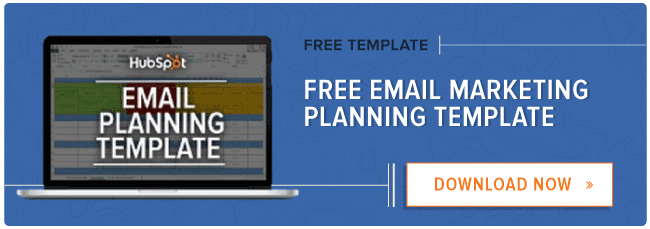 Sometimes, it can be rough to be an email marketer. Designing email templates, segmenting lists, drafting copy, planning your campaigns — a lot goes into executing a successful email marketing program.
Sometimes, it can be rough to be an email marketer. Designing email templates, segmenting lists, drafting copy, planning your campaigns — a lot goes into executing a successful email marketing program.
And if you’re a fellow email marketer, I’m sure you know all too well what I mean.
Here are 10 common things we email marketers can all relate to (don’t worry — they’re not all bad), complete with GIFs to make you smile and advice on how to rock your email marketing.
10 Things All Email Marketers Can Relate To
1) Realizing your email included a typo after you hit “send.”
 source: http://www.reactiongifs.com/r/powerrangers.gif
source: http://www.reactiongifs.com/r/powerrangers.gif
We’ve all done it. You hit the send button and then discover the typo. And of course, it’s already too late. Your stomach sinks, and there’s nothing you can do.
Sure, it’s just one typo, but that email was sent to thousands of people. You come off as sloppy and careless, and more importantly, your brand looks like it doesn’t have it together. Save everyone the embarrassment by always testing the email first, and don’t be afraid to ask a coworker to quickly proof it.
2) When you tell someone you’re an email marketer, and they say, “So you spam people, right?”
 source: http://www.reactiongifs.com/r/bmh.gif
source: http://www.reactiongifs.com/r/bmh.gif
Grr. You can’t even say, “Email marketers don’t do that!” Because sometimes they do. When you buy a list and email people, you’re intruding upon the inboxes of people who have never even signed up to hear from you. Unfortunately, there are enough marketers still relying on email blasts to these lists, so they give us respectable email marketers a bad rap.
Respectable email marketers — the ones who use inbound marketing — only email people who have opted in. As a result, their email campaigns are much more successful, since their email recipients expect to hear from them. Consider transitioning to an inbound strategy if you haven’t already — it will improve your channel’s effectiveness as well as your company’s credibility.
3) Every time your email’s clickthrough rate is higher than your benchmark.
 source: http://www.reactiongifs.com/r/tumblr_n35fr14IxQ1tw1vhco1_250.gif
source: http://www.reactiongifs.com/r/tumblr_n35fr14IxQ1tw1vhco1_250.gif
Email marketing is hard. Changes to how people consume email as well as an increase in the volume of email they receive has made it harder and harder to engage them. Getting through inbox clutter and past competitors’ emails and email filters is the marketing equivalent of making it through one of those intense Spartan races (you know, where they run through mud, barbed wire, and fire).
Be realistic when setting benchmarks for what email results are “good.” Look internally at how your emails have been performing rather than trying to measure yourself up to some industry standard — those are too broad and don’t account for your specific brand of marketing.
4) When you first found out marketing automation was a thing.
 source: http://www.reactiongifs.com/r/woah.gif
source: http://www.reactiongifs.com/r/woah.gif
For those of you who don’t know what it is, I promise, it will blow your mind. Marketing automation is a technique that uses software to automate your marketing, helping you communicate and engage with leads and customers in a scalable way. You can set up series of emails and more that are triggered by segmented lists and events that nurture your contacts down a specific path. It’s the Swiss Army Knife of marketing, because you can use it for all sorts of things including (but not limited to):
- Transactional emails, such as an order confirmation or a follow-up after an ebook download.
- Lead nurturing workflows, which help move leads down the marketing funnel in a scalable way.
- Re-engagement workflows, to reach out to inactive leads when they complete a qualified action.
- Customer delight, welcoming your new customers and keeping existing ones engaged.
- Sales notifications, so you can alert a sales rep when their leads complete an action such as submitting a decision-stage form.
Go on, say it. Whoa.
5) When someone realizes it’s you emailing them and not some spambot, and then they actually pay attention.
 source: http://www.reactiongifs.com/wp-content/uploads/2013/11/real.gif
source: http://www.reactiongifs.com/wp-content/uploads/2013/11/real.gif
Personalization is key to engagement. When you send an email from a real person instead of, say, Marketing Team at marketing@companyXYZ.com, it comes off as a lot more personal. And your audience wants to hear from a person, not a company. In fact, we’ve run several A/B tests and found that personalizing the sender name and email address increases open rates an average of 3%. In addition, aggregate data shows that using personalization in the sender increases CTR by 19%.
In addition to sender personalization, have some fun with the copy of your email. This means different things for different industries, but as a general rule of thumb, try to sound human. Use first name personalization if available in your email marketing software so your greeting reads as “Hi Bob” rather than “Hi there.” Position your copy in a way that relates to your target persona. Here are some other dynamic tags you can use in your emails to personalize your copy.
6) Getting a really mean reply to your marketing email.

Source: http://www.reactiongifs.com/r/brzltrs.gif
Let’s face it: Sometimes people are jerks. While we get a lot of nice responses to our marketing emails, we also regularly get some very rude responses, and although you know it’s not directed at you personally, sometimes you still take it, well … personally. But remember, when you let people opt into your emails (through forms on landing pages, for example), you’re less likely to run into this issue, since they voluntarily signed up to receive updates from you.
When you get snide, cruel, or expletive-laden emails, stay classy and brush it off your shoulder. Remember — people find it easier to be rude when it’s not face to face. It’s smart to just manually opt the haters out of your email list — they aren’t useful to your brand, and they’ll only hurt your engagement metrics anyway.
7) Every time some new article claims email is dead.

source: http://www.reactiongifs.com/r/jlaw-whtvr.gif
Sure. And the internet is on its way out, too.
News flash: Email is not dying. In fact, it’s doing the exact opposite: According to Radicati, there are more than 3.6 billion email accounts, and last year, Forrester claims that over 838 billion marketing messages were sent via email. In addition, ExactTarget reports that 91% of consumers report checking their email daily. See more email marketing stats here.
Numbers don’t lie.
8) When someone sends you a long reply demanding that you unsubscribe them, even though they could’ve just clicked the unsubscribe button at the bottom of your email.
 source: http://www.reactiongifs.com/r/ksbp.gif
source: http://www.reactiongifs.com/r/ksbp.gif
First things first: Do you give recipients the option to unsubscribe and change their email preferences in the footer of your emails? If not, not only are people totally within their right to angrily ask you to unsubscribe them, but you are also in violation of the CAN-SPAM Act. Avoid accruing hefty fines and hurting your company’s reputation by including an unsubscribe option in all your marketing emails.
If you do have an unsubscribe link in your footer, make sure it’s clear and easy to identify. Making it difficult for people to unsubscribe is a very poor user experience. Maybe this person just wasn’t ready to buy and was planning on coming back to your website later. By making them work for the unsubscribe, you’ve come off as sneaky and may have pushed them away for good. And for those folks who keep emailing you even though you’re doing everything right … just unsubscribe them already.
9) Working on a million email campaigns, and all of a sudden you have no idea what’s supposed to get sent when.
 source: http://www.reactiongifs.com/wp-content/uploads/2012/12/too-much.gif
source: http://www.reactiongifs.com/wp-content/uploads/2012/12/too-much.gif
We’ve all been there, and it sucks.
When you don’t have your campaigns well organized, things start to slip through. Maybe you forgot to schedule an email and it ended up hurting one of your coworkers’ marketing campaigns, or maybe you neglected to segment your list properly, resulting in a very ineffective email. Believe me: I’ve been there, and it’s not fun.
Don’t rely on email threads with your coworkers as your primary method of organization for email campaigns. Create a schedule, include important variables such as the segment you’re emailing, send date, and links to the featured content, and publish this schedule where your coworkers can see it to make it easy to collaborate and keep track of progress. Here’s a handy, free tool that will help you do all that.
10) When you open an email that isn’t mobile optimized.
 source: http://www.reactiongifs.com/wp-content/uploads/2013/07/nope.gif
source: http://www.reactiongifs.com/wp-content/uploads/2013/07/nope.gif
Dear fellow email marketers: Please, for the sake of everything email, optimize for mobile. 47% of all emails are opened on mobile devices, so you don’t have the option of ignoring this vital step in your marketing.
When you open an email on a phone or a tablet, the screen size is different than your computer. If you haven’t optimized your email, words are stretching past the screen, images are a wreck, and it’s a nightmare to read. And that means a good portion of your list is going to take one quick look at your email and hit “delete.” Most email software tools will have options to optimize for multiple screens, and here’s a tutorial on some of the important considerations to make when you’re optimizing email for mobile devices.
Email marketing can be frustrating. But when you know some of the shortcuts, tips, and tricks, it can also be one of the most rewarding jobs in marketing. So while you may relate to these entertaining email marketing gifs, I hope you also found the suggestions and tools useful. As a fellow email marketer, I’ve got your back.
![]()







